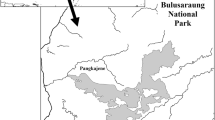Abstract
Biodiversity loss in tropical forests is a major problem in conservation biology, and nowhere is this more dire than in Southeast Asia. Deforestation and the associated loss of species may trigger shifts in habitat and feeding preferences of persisting species. In this study, I compared the habitat use and diet of long-tailed macaque (Macaca fascicularis) populations in Singapore from two time periods: museum specimens originally collected between 1893 and 1944, and living macaques sampled in 2009. I collected hair and used stable carbon and nitrogen isotope analysis to identify temporal changes in dietary source and trophic position, respectively. δ13C ratios were virtually identical, suggesting that macaques foraged in similar habitats during both time periods. However, δ15N ratios decreased considerably over time, suggesting that macaques today feed at a lower trophic level than previously. This decline in trophic level may be because of the disappearance or decline of other species that compete with macaques for fruit. This study highlights the effect of biodiversity loss on persisting species in degraded habitats of Southeast Asia, and improves our understanding of how species will adapt to further human-driven changes in tropical forest habitats.
Similar content being viewed by others
References
Becker BH, Beissinger SR (2006) Centennial decline in the trophic level of an endangered seabird after fisheries decline. Conserv Biol 20:470–479
Brook BW, Sodhi NS, Ng PKL (2003) Catastrophic extinctions follow deforestation in Singapore. Nature 424:420–423
Castelletta M, Sodhi NS, Subaraj R (2000) Heavy extinctions of forest avifauna in Singapore: lessons for biodiversity conservation in Southeast Asia. Conserv Biol 14:1870–1880
Corlett RT (1992) The ecological transformation of Singapore, 1819–1990. J Biogeogr 19:411–420
Corlett RT (1998) Frugivory and seed dispersal by vertebrates in the Oriental (Indomalayan) Region. Biol Rev 73:413–448
Crawford K, McDonald RA, Bearhop S (2008) Applications of stable isotope techniques to the ecology of mammals. Mamm Rev 38:87–107
Crooks KR, Soule ME (1999) Mesopredator release and avifaunal extinctions in a fragmented system. Nature 400:563–566
DeNiro MJ, Epstein S (1978) Influence of diet on the distribution of carbon isotopes in animals. Geochim Cosmochim Acta 42:495–506
DeNiro MJ, Epstein S (1981) Influence of diet on the distribution of nitrogen isotopes in animals. Geochim Cosmochim Acta 45:341–351
Farmer RG, Leonard ML (2011) Long-term feeding ecology of Great Black-backed Gulls (Larus marinus) in the northwest Atlantic: 110 years of feather isotope data. Can J Zool 89:123–133
Fry B (2006) Stable isotope ecology. Springer, New York
Fuentes A, Kalchik S, Gettler L, Kwiatt A, Konecki M, Jones-Engel L (2008) Characterizing human–macaque interactions in Singapore. Am J Primatol 70:879–883
Hoefs J (2004) Isotope fractionation mechanisms of selected elements. In: Hoefs J (ed) Stable isotope geochemistry. Springer, Berlin, pp 31–76
Kelly JF (2000) Stable isotopes of carbon and nitrogen in the study of avian and mammalian trophic ecology. Can J Zool 78:1–27
Lane DJW, Kingston T, Lee BPY-H (2006) Dramatic decline in bat species richness in Singapore, with implications for Southeast Asia. Biol Conserv 131:584–593
Lucas PW, Corlett RT (1991) Relationship between the diet of Macaca fascicularis and forest phenology. Folia Primatol 57:201–215
Lucas PW, Corlett RT (1998) Seed dispersal by long-tailed macaques. Am J Primatol 45:29–44
Nakagawa M, Hyodo F, Nakashizuka T (2007) Effect of forest use on trophic levels of small mammals: an analysis using stable isotopes. Can J Zool 85:472–478
Norris DR, Arcese P, Preikshot D, Bertram DF, Kyser TK (2007) Diet reconstruction and historic population dynamics in a threatened seabird. J Appl Ecol 44:875–884
Post DM (2002) Using stable isotopes to estimate trophic position: models, methods, and assumptions. Ecology 83:703–718
Ripple WJ, Beschta RL (2004) Wolves and the ecology of fear: can predation risk structure ecosystems? Bioscience 54:755–766
R Development Core Team (2010) The R project for statistical computing, version 2.11.1. http://www.R-project.org
Schoeninger MJ, Iwaniec UT, Glander KE (1997) Stable isotope ratios indicate diet and habitat use in New World monkeys. Am J Phys Anthropol 103:69–83
Sha JCM, Gumert MD, Lee BPY-H, Fuentes A, Rajathurai S, Chan S, Jones-Engel L (2009) Status of the long-tailed macaque Macaca fascicularis in Singapore and implications for management. Biodivers Conserv 18:2909–2926
Sodhi NS, Brook BW (2006) Southeast Asian biodiversity in crisis. Cambridge University Press, Cambridge
Sodhi NS, Posa MRC, Lee TM, Bickford D, Koh LP, Brook BW (2010) The state and conservation of Southeast Asian biodiversity. Biodivers Conserv 19:317–328
Stewart AME, Gordon CH, Wich SA, Schroor P, Meijaard E (2008) Fishing in Macaca fascicularis: a rarely observed innovative behavior. Int J Primatol 29:543–548
Whitmore TC (1992) Deforestation and species extinction in tropical moist forests. In: Whitmore TC, Sayer JA (eds) Tropical deforestation and species extinction. Chapman & Hall, London, pp 1–14
Winker K (2004) Natural history museums in a postbiodiversity era. Bioscience 54:455–459
Acknowledgments
The NSF East Asia and Pacific Summer Institutes (EAPSI) provided funding for research in Singapore. R. Corlett hosted me during my EAPSI internship, and K. Lim generously allowed me to collect hair from Raffles Museum specimens. M. Lute, A. Fuentes, and L. Jones-Engel allowed me to collect hair samples from live macaques sampled as part of a project on disease in macaques. M. Schoeninger provided invaluable advice as I planned this project, and allowed me to use her laboratory to clean and prepare the hair samples for isotope analysis. A. Somerville taught me how to clean and prepare the hair samples for isotope analysis. N. Sodhi and several anonymous reviewers provided valuable comments on the manuscript.
Author information
Authors and Affiliations
Corresponding author
About this article
Cite this article
Gibson, L. Possible shift in macaque trophic level following a century of biodiversity loss in Singapore. Primates 52, 217–220 (2011). https://doi.org/10.1007/s10329-011-0251-9
Received:
Accepted:
Published:
Issue Date:
DOI: https://doi.org/10.1007/s10329-011-0251-9




